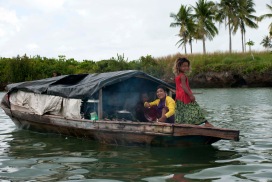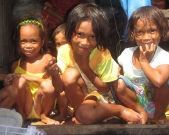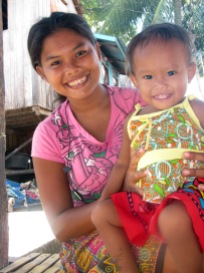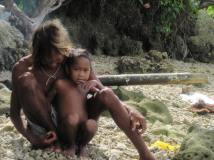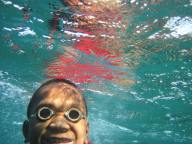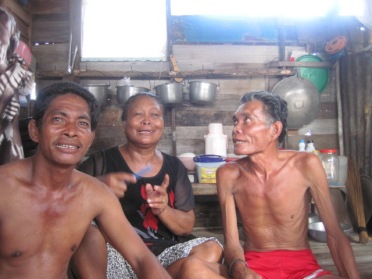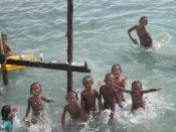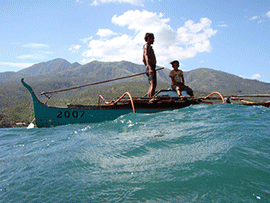Semporna – Renassiance of the Houseboat
At year-end, I and photographer Andreas Ragnatsson went to the Philippines and Malaysia to meet Sama Dilaut. In Davao, the Philippines, we spearfished with superb divers. In Semporna, Malaysia, we visited the islands of Bodgaya, Mabul, Sibuan and Maiga and talked to them who are still living on their “lepa” houseboats.
Different groups of Sama Dilaut
Sama Dilaut in Philippines, Malaysia and Indonesia can be divided into four groups, of which today only two are living on boats. The northernmost group is Sama Dilaut from Zamboanga, Basilan and Jolo, who are generally known as “Badjao” in the Philippines . They live today scattered over large parts of the Philippines, (eg, Davao, Manila, Cebu) where they fled after unrest in the Sulu Sea. None of them live on house boats today, but many still make a living from fishing and live along the shorelines.
The largest group of boat nomads is Sama Dilaut from Bongao, Tawi-Tawi, Philippines . Most of these, however, have fled to Sabah, Malaysia, where many still live on their house boats. Today, there are no nomads left in Tawi-Tawi because of the unsecure situation in the region. Many Sama Dilaut house-dwellers in Semporna told me that they want to return to their boat-dwelling lifestyle, which make them more mobile and give them better fishing opportunities. For many it is only a matter of money – if they would afford it they would build a houseboat and return to the sea.
A closely related group to Sama Dilaut of Tawi-Tawi is Sama Dilaut of Sitankai, Philippines, that used to live on the sea. Many of these people came to Semporna in the 60’s on their houseboats where they established the village Bangaw Bangaw. Today all of them live in houses
The fourth group is Sama Dilaut of Indonesia, who generally are called Indonesian Bajau. They speak a slightly different dialect than their relatives in the Sulu Sea but most words that are related to the sea are identical, as for example “amessi” (hook-and-line fishing), “amana” (speargun fishing) and “amosaj” (to paddle). Indonesian Bajau live over large parts of Sulawesi and even as far south as Flores. Today, only few Indonesian Bajau live on house boats and the number decreaces. Only ten years ago many Indonesian Bajau were boat-dwellers along the eastern coast of Sulawesi (eg, Lasolo) but today there are only few nomads in the Togian Gulf left.
Speargun Fishing in Philippines – an Ecological Living
It is always a pleasant experience to come to the Sama Community in Matina Aplaya, Davao City, Philippines. Almost 100 people greeted me when I entered the village in the beginning of December. I could see children playing drums, fishermen preparing their “pana” (speargun) and women nursing their small children.
Then followed one month of swimming, fishing, playing with children, playing volleyball and celebrating Christmas and New Year.
Skilled 10-year old fisherman
I had the opportunity to follow one of the younger fishermen in the village, Jimmy, 10,at sea. I followed him underwater while he caught fish after fish with his harpoon. He is one of few children in the village that has grew up as a traditional fisherman, and hence, one of few children that has ruptured his eardrum. However, it is getting more and more difficult to make a living from the sea, due to over-fishing and more extreme weather.
But why do they rupture their eardrums? In fact, it is seen as practical since diving is an everyday activity. The ruptured eardrum can be seen as an investment: If you are going to make more than 10 000 dives during your lifetime, and if you never have learned how to equalize properly, then rupturing your eardrum becomes a shortcut to the ocean’s depth. “If you rupture it once, you will have no problem diving throughout your life” one young fisherman explained. Of course, older men have hearing problems and the fishermen will get ear infections over the years as water enters their middle ears … but they are taking inherited medicines … and the inner ear will generally never be affected.
In the Sama community of Matina Aplaya it is still common that the fishermen make up to three week long journeys to abundant fishing spots further south in the Davao Gulf. It is not easy – but not either impossible – to make a living completely from the sea. They sleep on the boat: spearfish during the day and hook-and-line fish in the evening. When they return to the village they normally buy a big fish and share it with their families… Many of the fishermen continue to harvest at sea – no matter what the season or happenings around them.
How big is their ecological footprint?
This is the fourth time I visit the village since 2010 when I started to study about Bajau Laut right here – and I hope to be able to make many future visits. One new thing for this time was that a quite many families had started to make a living from selling of secondhand shoes, that they buy in the market in sacks for either 1 000 pesos or 2 800 pesos each. Then, they are repairing the shoes and selling them to people in Davao and neighboring cities.
In December it is also common that Sama and other local tribes of Davao are playing music and dance while going from house to house begging for food and money. The Sama children are performing with recycled drums, made by metal and plastic waste. A group of enthusiastic children can make 200-300 pesos a day in this way.
Many people might say that Sama are uncivilized and dirty – that they are begging parasites. But in fact they are making a lot of recycling services that the modern Philippine society doesn’t do. For example they collect a lot metal and plastic waste from the shorelines, they reuse and restore clothes and shoes, establish a flourishing second hand market, and they catch fish with sustaining fishing methods. Most of their money goes to purchasing of water and food, like cassava, fish and fruits – even if they also are buying Christmas gifts. Overall, their ecological footprint is nearly zero.
Recently, the Philippine spokesperson at United Nations climate change conference in Doha, Naderev Sano, made a long-lasting impression on many of the listeners. Only days before the eastern Mindanao of Philippines had been hit by a devastating typhoon… ”There is massive and widespread devastation back home. Heartbreaking tragedies like this are not unique to the Philippines”, he said, emphasizing that Philippines and other countries may face more extreme weather disturbances if climate change is left unchecked You can see his speech here: Plea by Naderev M. Sano of the Phillipines and read an article in the Guardian about the speech here: Will Philippines negotiator’s tears change our course on climate change?
Indeed, the Philippines and the world are facing many climate-related challenges – and I am sure that we can learn a lot from the Bajau tackling these problems!
Badjao Association of Matina Aplaya
Another new thing in the community is that they have organized themselves in an organization – The Badjao Associaition of Matina Aplaya. The purpose of the organization is to establish a long-term livelihood for the community, either on fishing or selling of clothes and pearls. For example, the members of the organization will be able to borrow money for a small cost. They are also planning to build a local school: “If the children can learn how to read and write in their own language, they will be able to attend the regular Philippine school”, Lolita, one of the community leaders, said.
In the beginning of January I am heading back to Malaysia – and from there I will go to Sulawesi, Indonesia, where I will live with the Bajo, another Sama Dilaut group, who have been separated from their relatives in Malaysia and Philippines for almost 200 years. In Sulawesi I will visit the isolated village Lasolo – one of the places where their might still be boat-dwelling Sama people outside of Borneo.
Sama Dilaut of Semporna: Fish Bombers or Peaceful Nomads?
For more than one month I have been living in Semporna, in Sabah, where I have visited remote islands and several Sama Dilaut (Bajau Laut) communities. I have talked to sea nomads, been diving, attained a wedding and continued to learn the basics of Sinama.
One thing that surprises me is the life pulse and energy I always feel when I visit a Sama community. Even if I go to Semporna or remote parts of Mindanao I always get the same feeling.
Hundreds of sea nomads
In Semporna hundreds of house boats have their moorage, either close to one of the many islands in the region or simply in Semporna town close to the Sama Dilaut communities Kampong Halo and Bangau Bangau. They make their living entirely from the sea: they are net fishing, hook-fishing, spear gun fishing and dive for sea cucumber and pearls. During low tide they also go along the shallow corals and collect sea shells. It is fascinating to see the water adaptation of the Sama – an adaptation that starts in early age. A child learns to swim when it is 2-3 years old, it learns how to paddle a boat at five and dive at the age of six.
Dynamite Fishing
Unfortunately, some of the Sama Dilaut fishermen are also involved in dynamite fishing and compressor diving. Fish bombing is, of course, devastating for the marine life as it completely destroys the corals. But as one fisherman told me: “when I go hook fishing I must wait a long time for a catch, but if I throw a bomb I will get plenty of fish in seconds!” Of course, bomb fishing is highly illegal and leads to imprison and big fines. I met one pregnant woman with small children whose husband and oldest son had been caught bombing fish, which left the family without livelihood.
It is important to note, however, that it is unusual that boat living Sama make a living from dynamite fishing. It is much more common among more settled, house-dwelling Sama Dilaut fishermen.
Refugees from Philippines
Nearly all Sama Dilaut in Sabah are refugees from the Philippines. Many of them lack Identity cards and passports. A majority doesn’t even have a birth certificate. Without ID you have no right to get medical support (it costs 50 RM, approximately 17 USD without ID for a medical checkup and only 1 RM if you are a Malaysian citizen) and schooling. However, many Sama Dilaut have a “lepa passport” (a houseboat passport) authorized by the local government which gives them right to stay in the waters of Sabah.
Probably, the reason behind Sama Dilaut’s partly devastating fishing methods is linked to the fact that they are not recognized as legal – as a matter of fact many Sama Dilaut do never set their foot on land because of fear of deportation. Hence, if you are living there illegally and don’t get any support from local authorities, you might be tempted to get involved in devastating fishing practices.
Ethnic discrimination
When I talk to the Sama Dilaut they all tell me one thing – they are afraid of the Tausug people of the Sulu – which have ruled the area for centuries. Today many Tausug are armed and some of them have been in part of the creation of the Abu Sayyaf guerilla. For decades they have been fighting against the Philippine government in order to establish a free Muslim state in southern Philippines. Recently, a peace agreement were settled which has calmed the overall situation, but single Sama individuals are still under huge threat (see: Philippines peace deal is far from a done deal for more information). Their catch and their machines are taken under night. Young women are forced to marry which make them escape in the middle of the night. Bombs have been thrown into their houseboats.
In Philippines, the police don’t do much to ease the situation for Sama Dilaut. In Malaysia, however, the police and military are very active, and thousands of tourists are arriving every year, which make the situation calm.
Have they always been nomads?
It is estimated that the nomadic lifestyle of Sama Dilaut is more than 1000 years old, but I have wondered if the present day sea nomads always have been living in the boat, or if they till recently have been living in houses? During my first month of stay with Sama Dilaut I have been asking many nomads about their history. As a matter of fact, some of the present day sea nomads have actually quite recently been living in houses in Philippines, but they resurrected their forefathers way of living when they came as refugees to Malaysia. It is still unclear how many of the nomads that have been nomads for generations, and that is one question I would like to figure out during my six month long stay in Southeast Asia.
In one week I am going to Philippines where I will visit the Sama Dilaut community in Matina Aplaya, Davao City. Here many people are living entirely on spear-gun fishing and they use no compressors and no dynamite. I am really looking forward to come back to Mindanao!

